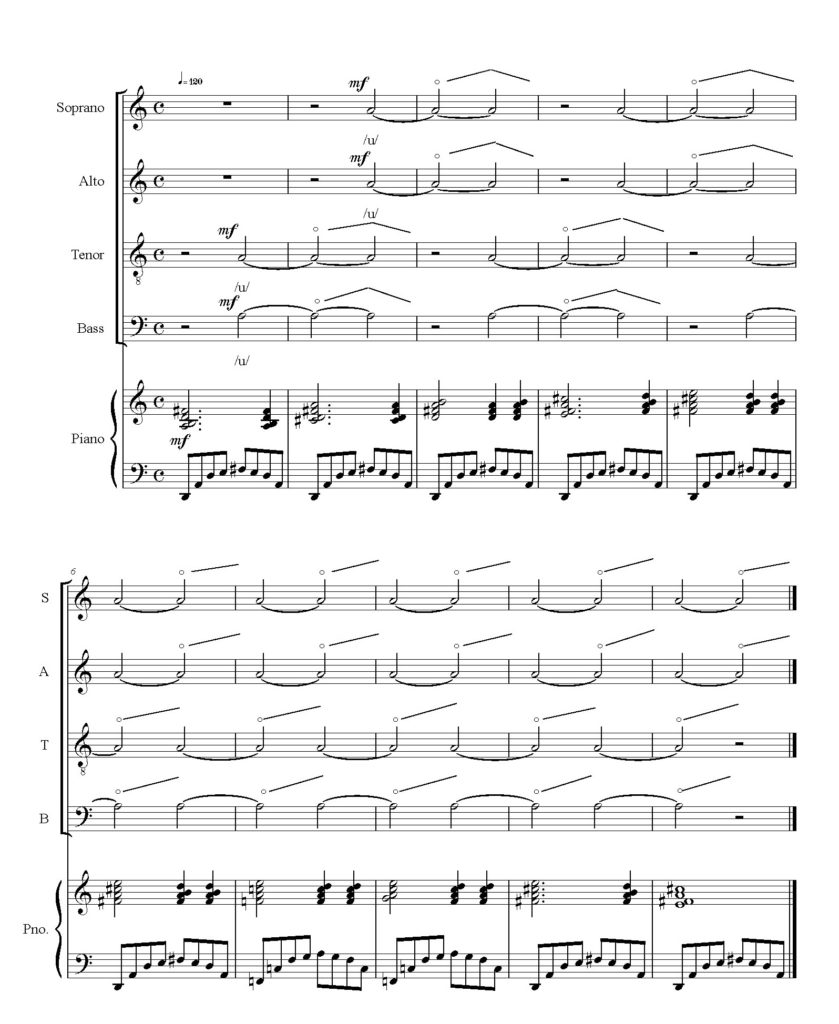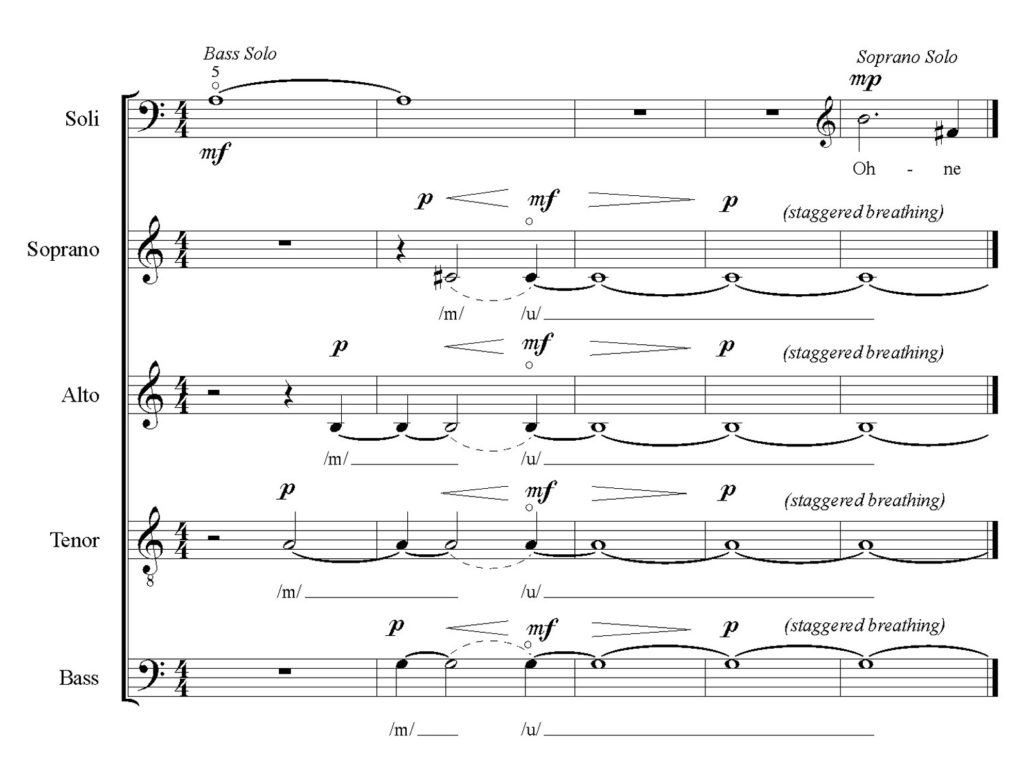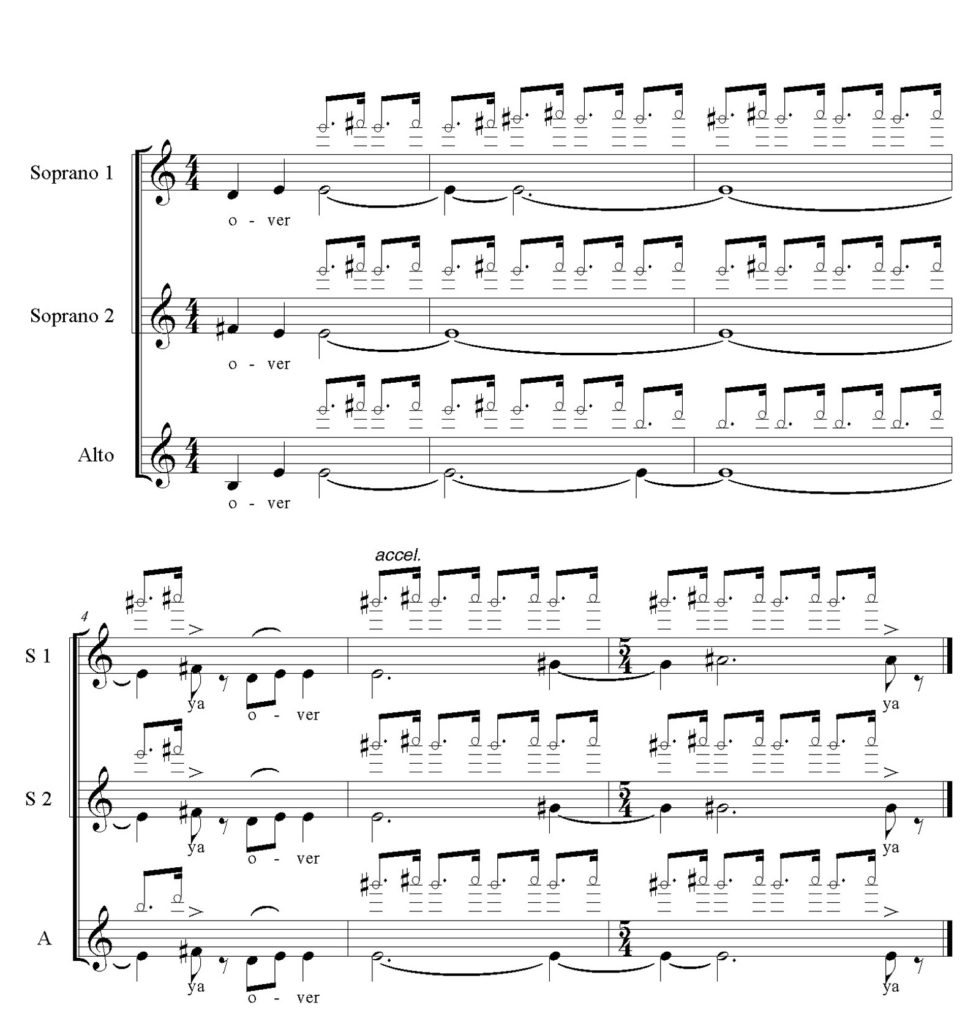Overtone Singing: Not Just for Monks and Shamans Anymore
Stuart Hinds, composer, singer, choral conductor, and teacher
The last decade has witnessed a dramatic increase in the popularity of overtone singing in its various forms, and choral music is no exception. More new works for chorus with overtone singing are being composed and more choirs are giving it a try. Overtone singing is being recognized now as a true musical genre that will continue to grow in acceptance as more people are introduced to it. Overtone singing may embrace a wide variety of musical styles and expressive possibilities, and it has a powerful potential for physical and intellectual benefit as well. Overtone singing sounds good, and it is good for you.
The purpose of this article is to de-mystify overtone singing and to offer compelling reasons for choir directors to try it with their choirs. Overtone singing is much more than a mere special effect. It is a powerful means of expression that choirs can take advantage of. It is also a useful tool for voice development and ear training. It is easier to sing overtones than some directors might think, and students enjoy it very much.
The references given at the end suggest resources for information on topics that cannot be included within the limitations of this article:
- the historical background of overtone singing and its current uses (Tongeren)
- a scientific explanation of what happens vocally in overtone singing (Levin/Edgerton)
- a method for teaching the technique to a choir (Hinds)
There is also a list of recommended compositions for choirs using overtone singing for the first time.
Before proceeding, a brief definition of overtones and their function in music is in order. Every musical note is actually a composite sound consisting of a fundamental tone, which is usually the pitch we perceive, combined with a number of additional pure tones above it called harmonics or overtones. These overtones are not normally heard individually, but they are important elements of the sound. The greater or lesser prominence (amplitude) of some of the overtones over the others determines the timbre, or tone color, of the note. It is the overtone structure, called the ‘spectrum’, which makes the sound of each voice or instrument unique and identifiable, and allows us to distinguish the sounds of the various musical instruments and also to recognize individual voices. The significance for singers is that overtones are the very basis of vowels, timbre, resonance, and intonation.
The term ‘overtone singing’ refers to techniques that allow a singer to isolate one of the natural harmonic partials in the overtone series of a sung fundamental pitch, thus making audible two discrete pitches simultaneously. This phenomenon is accomplished by altering the shape of the vocal tract in the same way one uses vowels in speech or singing. In the traditional overtone-singing styles, the singer typically creates a drone-based musical texture with a melody of overtones over an unchanging fundamental pitch.
However, the overtone singer is not necessarily limited to a static fundamental note. The author has developed a truly contrapuntal style of singing, vocally producing two musical lines simultaneously – the fundamental line and the overtone line. One can move both fundamental and overtone lines independently, as long as each note of the overtone line is a natural harmonic of the current fundamental pitch. More and more singers are beginning to sing polyphonically, and this ability can certainly be exploited in choral music.
Figure 1 provides a notated example of an overtone series on the fundamental pitch G in men’s range. The interval pattern of the overtone series is always the same relative to the fundamental pitch. Remember that these are not exactly the same as equal-tempered pitches: the octaves and fifths are perfect (i.e. do not beat), the 5th partial is a big major third, and the 7th and 11th partials are much flatter. As one progresses beyond the 12th partial, the intervals become progressively smaller.
(Click on the image to download the full score)

Audio files of the author singing an overtone series on G and a short excerpt of polyphonic overtone singing can be heard at www.stuarthinds.com on the Sound Clips page, along with recordings of several compositions that use the technique.
Overtone singing is perfectly natural and safe for the voice when done properly. Some singers who practice Tuvan/Mongolian ‘throat singing’ techniques may apply muscular pressure in an attempt to suppress the fundamental in favor of the overtones, but it is possible to produce overtones without any such stress, and teachers should monitor their students to make sure no vocal abuse is taking place. All the vocal tract manipulations in overtone singing occur in the resonating areas of the vocal tract, not the phonating area. The types of vocal tract shaping used in overtone singing are the same as those used in traditional singing when changing vowels, registers, or timbre. None of the adjustments of the vocal tract used in overtone singing is inconsistent with good ‘open throat’ singing.
There are several advantages in using overtone singing with a choir. First, there is the potential benefit of overtone singing relative to improvements in normal singing, particularly the effects on vocal resonance and increased understanding of the relationships between overtones, vowels, resonance, and timbre. Secondly, overtone singing contributes to better musicianship in general, as a result of training the ear in interval recognition and intonation. (For more detailed information about these topics, see ‘Argument for the Investigation and Use of Overtone Singing,’ in the Journal Of Singing, Fall 2005).
Consider also that overtone singing is a multicultural activity – an opportunity to learn about and celebrate the music of other cultures. Overtone singing also adds variety to concert programs and to rehearsal regimes. Singers will enjoy doing it and benefit from the experience.
The main reason for using overtone singing in music is of course the beauty of the sound. That distinctive sound is both effective and affective; it can be a powerful means of expression. When people hear overtone singing for the first time, the universal reaction is one of amazement. With its otherworldly quality, it is easy to see how the sound of overtone singing is often associated with sacred utterance.
It should be emphasized that anyone can learn to sing in this manner. The author firmly believes that any person who can breathe, phonate, and form vowels can perform overtone singing. Moreover, one does not have to be either a virtuoso singer or a specialist in overtone singing to enjoy overtone singing. In fact, most choral works with overtone singing do not call for a particularly high level of overtone singing technique. As the genre continues to develop, a repertoire will be generated, including works demanding a wide range of skill levels.
Of course, if a choir is to have success with an overtone-singing piece, the director must be fairly secure in the technique. Even if a clinician is hired to do a workshop session with the choir, the director must still do all the follow-up and should have some idea of what is going wrong if a student has difficulty. For those who work in an educational setting, this might be a good summer holiday or semester break project. You can learn the basic technique on your own using the video demonstration created by the author to accompany his article (see below). Then, it is not that difficult to find a few minutes here and there to get in a little practice: in the shower, driving, waiting for an appointment or for your kettle to boil. You will be amazed at how well you can do in a couple of weeks with just a few minutes of casual practice a day.
A complete lesson plan for teaching overtone singing to a choir can be found in the author’s article, ‘How to Teach Overtone Singing to a Choir’ in the Choral Journal (USA), October 2010 issue. A video demonstration by the author that accompanies the article is posted at www.stuarthinds.com.
You are likely wondering how much can be expected from singers who have just learned the basic technique. Certainly their abilities will be limited, but the choral effect of many voices together makes it possible to get excellent results with beginners, especially experienced choral singers with good basic vocal technique at the outset. In general, singers should not be expected to have much control over the precise overtones produced, so there will be a certain amount of indeterminacy, and that fact should be taken into account in compositions to be performed by singers of limited overtone-singing skills. The best effects can be achieved in musical situations where some indeterminacy is actually a desirable quality.
A few examples follow, ones which demonstrate some of the ways overtone singing may be effectively used by choirs new to the technique. In all these compositions, an attempt was made to incorporate and integrate overtone singing in musical and meaningful ways. They show how various overtone-singing techniques have been employed for purely musical effects such as timbre contrast, dramatic gesture, and the creation of texture. Additionally, some ways overtone singing can be evocative of the text (or better, evoked by the text) are presented.
Consider the composition Autumn Moon (SATB and piano, with some divisi). Most of the piece has no overtone singing at all. There are two brief spots where overtone singing is used as text painting (at ‘or when it hides for a moment behind a passing cloud’ and ‘I hear the song of the wind in the branches’). In these passages, the singers are given only the fundamental pitch and allowed to improvise on the partials that work best for them, thus creating a subtle but complex and colorful texture. Overtone singing is prominently featured only in a passage where the melody and harmony are taken over by the piano while the choir creates a harp-like texture of overtone glissandi, with the women’s voices alternating and overlapping with the men’s [Figure 2]. The singers need not be precisely in unison on the partials of these glissandi as long as they create the desired shape, ascending or descending, at the proper time metrically. The small circle over the notehead indicating harmonics is a notational technique found in scoring for strings. The vowel /u:/ is specified to produce a lower partial as a starting point for the glissando, not to be sustained.
(Click on the image to download the full score)

It is common for the overtone singing in a choral piece to consist of no more than a given fundamental pitch and the direction to bring out overtones, ad lib., but it is easy to do more without raising the difficulty level. Simple verbal instructions can be used to suggest more specific musical effects. In one passage from Winter (SATB unaccompanied), singers are asked to concentrate on the highest harmonic partials possible to illustrate the imagery of freezing cold in the lyrics. Further, the lyrics themselves are used to generate overtone-singing effects. In the bass part, measure 45, diphthongs in the words are elongated to produce glissandi of overtones, descending – ‘fierce’ and ‘fearful’ (/i3/) and ascending – ‘voices’ (/oi/).
(Click on the image to download the full score)

In this piece for two-part children’s choir, the /n/ is used in alternation with overtone singing to create an on/off effect of the overtones. The use of the vowel /i/ means that high-pitched harmonic partials will be produced. Again, the descending glissando gestures are notated graphically.
(Click on the image to download the full score)

Though the lower partials of any fundamental pitch are triadic, overtone singing is not limited to tonal or modal music. Any type of chord configuration can still be used in the fundamental part. In this passage from Meeres Stille (SATB unaccompanied), a whole-tone cluster is constructed without overtones and then overtones are added in a dynamic gesture. The /u/ vowel will produce low-pitched overtones.
(Click on the image to download the full score)

The following excerpt from The Wind (SSA unaccompanied) uses overtone singing as a rhythmic feature and a celebration of the ethnic origins of overtone singing in central Asia. The idea comes from Tuvan throat singing, where the dotted rhythm is used to represent the sound of horses galloping. In this case, specific partials were notated, but they may be treated as indeterminate because it is the rhythmic neighbor-tone gesture that is of greatest importance here. Other passages in this work use overtone glissando shapes to represent the whistling wind.
(Click on the image to download the full score)

One should not think that overtone singing in choral music is limited to these types of textures. There are more and more works being composed that call for a higher level of overtone-singing skill, requiring control of the partials being sung and even polyphonic singing. And greater skill allows a greater range of musical expression.
Directors of choirs of all ages and singing ability are strongly encouraged to consider trying overtone singing. It is easier to sing overtones than some directors might think. The basic technique can be taught in just a few minutes, and it does not require much rehearsal time to make good progress. Overtone singing can easily be incorporated into the warm-up regime, and is an outstanding platform for the teaching or improvement of vocal resonance and intonation. The time spent on overtone singing will pay dividends in improved awareness of the voice, increased musical cognition, and the enjoyment of singing.
To help you get started, a list of suggested compositions for chorus with overtone singing is given below. This information is primarily targeted at directors who have never used overtone singing with their choirs before. These works have been recommended because they offer a good chance of success and choir members have enjoyed singing them. The principal selection criterion for these pieces was that they be appropriate for choirs using overtone singing for the first time. This means that singers are not expected to bring out particular harmonics or change the fundamental while singing. The result of the overtone singing is therefore somewhat indeterminate, but that type of texture can be used to good effect in certain musical situations, as these works attest.
Ben Allaway – Walking Songs (2002, Thresholds)
Vaclovas Augustinas – Anoj puséj Dunojélio (Hinshaw)
Stuart Hinds – Autumn Moon (2004, Hofmeister)
Stuart Hinds – Winter (2005, Hofmeister)
Sarah Hopkins – Past Life Melodies (1991, Morton Music, several voicings available)
Knut Nystedt – Immortal Bach (1988, Norsk Musikforlag)
Peteris Vasks – Piedzimšana (2008, Schott)
References
Hinds, Stuart: An Overtone Experience/Eine Oberton Erfahrung, Traumzeit, 2012.
– ‘Argument for the Investigation and Use of Overtone Singing’, Journal of Singing, Fall 2005.
– ‘How To Teach Overtone Singing to a Choir’, Choral Journal, October 2010.
– ‘New Music for Chorus with Overtone Singing’, Choral Journal, March 2007.
Levin, Theodore C. and Michael E. Edgerton: ‘The Throat Singers of Tuva’, Scientific American, September 1999.
Tongeren, Mark C. van: Overtone Singing: Physics and Metaphysics of Harmonics in East and West, Amsterdam: Fusica, 2002.